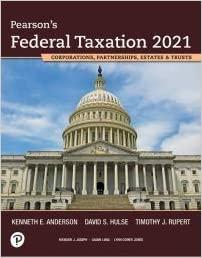One way to compare the accumulation of income by alterative business entity forms is to use mathematical
Question:
One way to compare the accumulation of income by alterative business entity forms is to use mathematical models. The following models express the investment after-tax accumulation calculation for a particular entity form:
Pass-through entities (S corporations, partnerships, and LLCs): ATA = [1 + R(1 - 0.8 tp)]n
C corporation: ATA = [1 + R(1 - tc)]n (1 - tg) + tg
where: ATA = after-tax accumulation in n years
R = before-tax rate of return;
tp = owner’s marginal tax rate on ordinary income
0.8tp = owner's marginal tax rate as adjusted to reflect the 20% QBI deduction
tc = corporation’s marginal tax rate
tg = owner’s tax rate on capital gains
n = number of periods
For each alternative business form, the owner makes an initial investment of $1. The following operating assumptions apply:
Before-tax rate of return (R) = 0.18
Marginal tax rate for owner (tp) = 0.37 and 0.8tp = 0.296
Corporate tax rate (tc) = 0.21
Capital gains rate (tg) = 0.238 for regular capital gains, including the 3.8% tax on net investment income
Investment horizon (n) = 2, 5, or 30 years
A pass-through entity distributes only enough cash each year for the owner to pay his or her taxes. Also, the shareholder claims the qualified business income (QBI) deduction. The corporation pays no dividends. The shareholder sells his or her stock at the end of the investment horizon, and the shareholder’s gain is taxed at capital gains rate. (See Chapter I:18 of the Individuals volume for a detailed explanation of these models.)
Required:
What is the after-tax accumulation if each business form is operated for the investment horizon and then sold for the amount of the accumulation? Which entity form is best for each investment horizon? For the C corporation alternative, do the analysis with and without the 100% Sec. 1202 exclusion.
Step by Step Answer:

Federal Taxation 2021 Corporations, Partnerships, Estates & Trusts
ISBN: 9780135919460
34th Edition
Authors: Timothy J. Rupert, Kenneth E. Anderson, David S. Hulse





